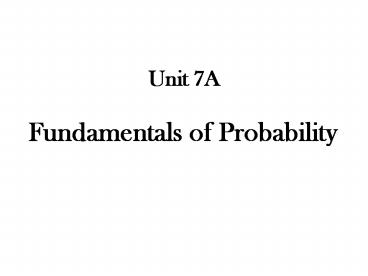Unit 7A PowerPoint PPT Presentation
1 / 20
Title: Unit 7A
1
Unit 7A
- Fundamentals of Probability
2
Outcomes Events
- Example Over a period of 8 years, a family has
3 children. Each birth is an event. List the
different possible outcomes that would result in
the event of 2 boys and 1 girl. - Outcomes are the most basic possible results of
observations or experiments. - An Event consists of one or more outcomes that
share a property of interestso an Event is a
specific type of outcome.
3
Counting Outcomes
The Multiplication Principle is a method for
counting outcomes. For a sequence of two
events in which the first event can occur M ways
and the second event can occur N ways, the events
together can occur a total of M N
ways. Example 1 How many outcomes are possible
when you flip a coin twice? Example 2 How many
outcomes are possible when you roll two
dice? The Multiplication Principle holds for
more than two events. Example 1 How many
outcomes are possible when you flip a coin 3
times? Example 2 The sports car you want come
with or without a sunroof, with or without power
windows, and in red, black, or green. How many
different versions of the car are available?
Try 23 30
4
Probability
- Every event has a certain probability, or
likelihood of happening. - The probability of an event is expressed as
- P (event).
- Usually upper case letters are used to represent
events. - For example, we could say that A is the event of
getting heads when a coin is tossed. - So, P(A) would be the probability of getting
heads when a coin is tossed.
5
Probability Limits
- The probability of an impossible event is 0.
- The probability of an event that is certain to
occur is 1. - Any event A has a probability between 0 and 1,
inclusive.
0 P(A) 1
6
Three Types Of Probabilities
- I. Theoretical Probabilities
- II. Empirical Probabilities
- III. Subjective Probabilities
7
I. Theoretical Probability
A theoretical probability is based on a model in
which all outcomes are equally likely.
Let A be an event.
Example What is the probability of having 2
boys and 1 girl when having 3 kids?
Try 31 - 47
8
Example
Find the probability of rolling a 7 when a pair
of fair dice are tossed.
Do you remember how to count outcomes?
9
II. Empirical Probability
An empirical probability is based on observations
or experiments. It is the relative frequency of
the event of interest.
Examples of Empirical Probabilities
include Baseball batting averages. Basketball
free throw shooting percentages.
10
Computing An Empirical Probability
Conduct (or observe) a procedure a large number
of times, and count the number of times that
event A actually occurs. Based on these actual
results P(A) is estimated as follows
11
Example
An allegedly fair die was tossed 563 times. The
number 4 occurred 96 times. What is the
probability that the next toss will result in a
4? If you toss a genuinely fair die, what is
the probability of tossing a 4?
Try 49 54
12
III. Subjective Probability
A subjective probability is an estimate based on
experience or intuition.
Examples An economist was asked What is the
probability that the economy will fall into
recession next year? The economist said the
probability was about 15. Theres a 60 chance
that UGA will win the national championship this
year.
13
Probability Of An Event Not Occurring
Suppose the probability of an event A is
P(A). P(A) P(not A) ______ What is the
probability that the event A does not occur?
P(not A) 1 - P(A)
Try 57 64
14
Probability Distribution of an Event
A probability distribution represents the
probabilities of all possible events. In this
course, you will make probability distributions
in the form of a table. One column of the
table lists each event and the other column lists
each probability. The sum of all the
probabilities must be 1.
15
Making A Probability Distribution
Step 1 List all possible outcomes.outside the
table. Step 2 List each event in the 1st column
of the table. Step 3 Find the probability of
each event using the theoretical method. Step 4
List the probabilities in the 2nd column of the
table. Remember that the sum of all the
probabilities must be 1.
16
Example Suppose you throw a pair of dice. Let
x be the sum of the numbers on the dice. Make a
table for the probability distribution of the
event x.
17
Example Suppose you toss a coin twice. Let x
be the total number of tails on the tosses. Make
a table for the probability distribution of x.
Example Suppose a coin is tossed thrice. Make
a probability distribution for the number of
heads.
Try 65 66.
18
Odds
The odds for (or odds in favor of) an event A
The odds against (or odds on) an event A
19
Examples
- What is the probability of rolling a 4?
- What is the probability of not rolling a 4?
- The odds for rolling a 4 on a die is
- The odds against rolling a 4 on a die is
- What is the probability of drawing a 7 from a
deck of cards? - What is the probability of not drawing a 7?
- What are the odds for drawing a 7?
- What are the odds against drawing a 7?
Try 67 70
20
Odds In Gambling
In gambling, the odds on (odds against) usually
expresses how much you can gain with a win for
each dollar you bet.
EXAMPLE At a horse race the odds on the horse
Median are given as 5 to 2. If you bet 12 on
Median and he wins, how much will you gain?
Try 71 72

